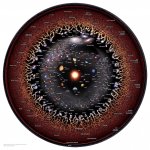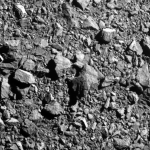But this is the operative: "but are being carried by the expansion of the lattice itself". How is this 'not' movement? What scientific law does only it's "apparent" movement satisfy? What scientific law does considering it actual "movement" violate? Or better yet, what cosmological feathers are being ruffled by accepting such a notion? Why can't we perceive it legitimately from the outside looking in?Another way to visualise the Universe is as a lattice.
View attachment 1094635
In this analogy, each cube is a cluster of galaxies, and the connecting rods represent the space between these clusters. When the Universe expands, imagine that every rod connecting the cubes grows longer at an even pace. Every single cube gets further and further away from every other cube, but the size of the cubes themselves stays the same. The cubes are not moving along the latticework but are being carried by the expansion of the lattice itself.
https://www.universeadventure.org/big_bang/expand-galaxy.htm#:~:text=The Apparent Movement of Galaxies The expansion of,appear to be moving apart from each other.
In theory, there is a subtle difference between moving through space and moving with space. In practice however, I don't think there is a way to differentiate (by measurement) between the two.
Why can't we perceive it legitimately from the outside looking in?
You are questioning the use of words when words are woefully inadequate to describe the expansion of the Universe.
Saying that we can be on "the outside looking in" suggests the Universe has an edge when it is either infinite in size or wraps around on itself.
And how would you explain the apparent movement of distant galaxy clusters at speeds exceeding the speed of light without invoking the metric expansion of space itself?
So then what is the proper or ‘correct’ vernacular?In theory, there is a subtle difference between moving through space and moving with space. In practice however, I don't think there is a way to differentiate (by measurement) between the two.
I'm merely attempting to successfully interpolate a scenario for the sake of comprehension. We have drawings and maps of the universe for this very purpose. Work with me here and do your best to glean the gist from my "woefully inadequate" ability to communicate. But please don't equate this to my ability to comprehend.You are questioning the use of words when words are woefully inadequate to describe the expansion of the Universe.
Saying that we can be on "the outside looking in" suggests the Universe has an edge when it is either infinite in size or wraps around on itself.
And how would you explain the apparent movement of distant galaxy clusters at speeds exceeding the speed of light without invoking the metric expansion of space itself?
I did not use the words "woefully inadequate" to describe your ability to communicate.
Please do not put words in my mouth.
I do not have the answers you seek.
You need to consult someone who combines the abilities of Linguist, Physicist, Mathematician and Engineer.
Where is Steve when you need him? 🙂
Please do not put words in my mouth.
I do not have the answers you seek.
You need to consult someone who combines the abilities of Linguist, Physicist, Mathematician and Engineer.
Where is Steve when you need him? 🙂
My response was rhetorically in keeping with your generalization, albeit with a good measure of self reflection. I'm just having a conversation here. I mean no animosity. I'm here to learn. From your insightful input so far, I believe you have the answers I'm looking for.I did not use the words "woefully inadequate" to describe your ability to communicate.
Please do not put words in my mouth.
I do not have the answers you seek.
You need to consult someone who combines the abilities of Linguist, Physicist, Mathematician and Engineer.
Where is Steve when you need him?
To get back on-topic, I do admire Doctor Sabine Hossenfelder's attitude to New Physics, She is skeptical.
Nobody has any idea what is going on in Cosmology and Physics! Makes zero sense to me.
If General Relativity makes sense we must concede that Classical Mechanics makes sense too. Consider this:

What does this mean? Anyone interested in Plutinos, Cubewanos and Twotinos must concede it's down to orbital resonances:

Triton, near Neptune, is currently considered a captured KBO.
As a Mathematician, I think these things are crucial:

Trans-Neptunian and Kuiper Belt Objects are most interesting.
https://en.wikipedia.org/wiki/Kuiper_belt

But must admit that it is currently unsolved if anti-matter repels matter. The LHC is trying to solve this. May relate to the expansion of the Universe.
We must wait and see.
Best Regards from Steve, in Portsmouth UK.
Nobody has any idea what is going on in Cosmology and Physics! Makes zero sense to me.
If General Relativity makes sense we must concede that Classical Mechanics makes sense too. Consider this:
What does this mean? Anyone interested in Plutinos, Cubewanos and Twotinos must concede it's down to orbital resonances:
Triton, near Neptune, is currently considered a captured KBO.
As a Mathematician, I think these things are crucial:
Trans-Neptunian and Kuiper Belt Objects are most interesting.
https://en.wikipedia.org/wiki/Kuiper_belt
But must admit that it is currently unsolved if anti-matter repels matter. The LHC is trying to solve this. May relate to the expansion of the Universe.
We must wait and see.
Best Regards from Steve, in Portsmouth UK.
Last edited:
I believe you have the answers I'm looking for.
I'm flattered, but trying to reduce the concept of the expansion of the Universe to metaphors in an attempt to relate it to familiar experience just won't work.
We have drawings and maps of the universe for this very purpose (comprehension).
I'm not sure to what drawing/maps you refer, but it gives me an opportunity to attach a new annotated version of the logarithmic map of the observable Universe. (Note that the observable Universe is finite in its radius while the actual Universe is probably infinite.)
Attachments
I have no idea. Sorry.So then what is the proper or ‘correct’ vernacular?
See DART's final images here: https://www.nasa.gov/feature/dart-s-final-images-prior-to-impact
Attached, is the last complete image of Dimorphos, taken 12 kilometres from the asteroid and 2 seconds before impact.
The image shows a patch of the asteroid that is 31 metres across.
Attached, is the last complete image of Dimorphos, taken 12 kilometres from the asteroid and 2 seconds before impact.
The image shows a patch of the asteroid that is 31 metres across.
Attachments
Sabine, I wish you where in this thread...
You mean "were", but do you think she would consider us sufficiently erudite to correspond with?
I wonder where I am placed on the "nine levels of nothing", or should I say, the "nine levels of ignorance"! 🤓
Buy one of my T shirts - that's what cheese said! 🧀
Would those be loose rocks or is the whole asteroid a conglomerate?See DART's final images here: https://www.nasa.gov/feature/dart-s-final-images-prior-to-impact
Attached, is the last complete image of Dimorphos, taken 12 kilometres from the asteroid and 2 seconds before impact.
The image shows a patch of the asteroid that is 31 metres across.
From what I read, asteroids formed from small pieces of rock and metal which ran into each other.
Provided they didn't collide too hard, the pieces would stick together.
So an asteroid is more a floating pile of entangled rubble than a solid rock.
A "conglomerate", a "thing consisting of different and distinct parts which are stuck together", would be a good description of an asteroid.
Provided they didn't collide too hard, the pieces would stick together.
So an asteroid is more a floating pile of entangled rubble than a solid rock.
Would those be loose rocks or is the whole asteroid a conglomerate?
A "conglomerate", a "thing consisting of different and distinct parts which are stuck together", would be a good description of an asteroid.
So far my favorite dart collision observation.
https://www.cnet.com/science/space/...on-between-dart-probe-and-asteroid-dimorphos/
https://www.cnet.com/science/space/...on-between-dart-probe-and-asteroid-dimorphos/
- Status
- Not open for further replies.
- Home
- Member Areas
- The Lounge
- What is the Universe expanding into..



